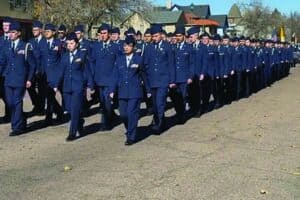On June 27, 1950, the United States officially entered the Korean War. The U.S. supported the Republic of Korea (South Korea) in repelling an invasion from the Democratic People’s Republic of Korea (North Korea).From a National Geographic summary, the Empire of Japan had occupied the Korean Peninsula during World War II. After Japanís defeat, the victorious Allies split the peninsula on the 38th parallel. U.S. troops occupied the southern part, while Soviet troops occupied the northern part. The two Koreas engaged in border conflict, which escalated when North Korea invaded South Korea on June 25.The Korean War was a proxy war for the Cold War. The West ó the United Kingdom and the U.S., backed by the United Nations ó supported South Korea, while communist China and the Soviet Union supported North Korea. The Korean War ended three years later, with millions of casualties. The war ended with virtually no change in the border. The Korean Peninsula is still divided, with military personnel from both North and South Korea occupying the DMZ (demilitarized zone).The chronology of events begins with a History.com account detailing how in the South, the anti-communist dictator Syngman Rhee enjoyed the reluctant support of the American government; in the north, the communist dictator Kim Il Sung enjoyed the slightly more enthusiastic support of the Soviets. Neither dictator was content to remain on his side of the 38th parallel, however, and border skirmishes were common. Nearly 10,000 North and South Korean soldiers were killed in battle before the war even began.According to iwm.org.uk, on June 25, 1950, the Korean Peopleís Army invaded South Korea and rapidly advanced southward, trapping South Korean and American troops in a small perimeter around the port of Pusan. The United Nations was quick to respond and immediately encouraged its members to support the South. Many countries sent in troops, including the United States, Great Britain, Australia, Canada, India, New Zealand and South Africa.History states, at first, the war was a defensive one to get the communists out of South Korea, and it went badly for the Allies. The North Korean army was well-disciplined, well-trained and well-equipped. Rheeís forces in the South Korean army, by contrast, were frightened, confused and seemed inclined to flee the battlefield at any provocation. Also, it was one of the hottest and driest summers on record, and desperately thirsty American soldiers were often forced to drink water from rice paddies that had been fertilized with human waste. As a result, dangerous intestinal diseases and other illnesses were a constant threat.By the end of the summer, President Truman and Gen. Douglas MacArthur, the commander in charge of the Asian theater, had decided on a new set of war aims. Now, for the Allies, the Korean War was an offensive one: It was a war to ìliberateî the North from the communists.Initially, this new strategy was a success. The Inchíon Landing, an amphibious assault at South Koreaís west coast city of Inchíon, pushed the North Koreans out of Seoul and back to their side of the 38th parallel. But as American troops crossed the boundary and headed north toward the Yalu River, the border between North Korea and Communist China, the Chinese started to worry about protecting themselves from what they called ìarmed aggression against Chinese territory.î Chinese leader Mao Zedong sent troops to North Korea and warned the United States to keep away from the Yalu boundary unless it wanted a full-scale war.In early 1951, the Chinese offensive lost its momentum and the UNC, bolstered by the revitalized 8th U.S. Army led by Gen. Matthew B. Ridgway, retook Seoul and advanced back to the 38th parallel. From July 1951, until the end of hostilities the battle lines remained relatively stable and the conflict became a stalemate.The Truman Administration abandoned plans to reunite North and South Korea and instead decided to pursue limited goals to avoid the possible escalation of the conflict into a third world war involving China and the Soviet Union. When MacArthur publicly challenged the Truman Administration’s conduct of the war, the president, ì… concluded that Ö MacArthur is unable to give his wholehearted support to the policies of the United States Government …” and relieved him from command in April 1951, replacing him with Ridgway, according to esienhowerlibrary.gov.From History.com, peace talks initially began in July 1951, at Panmunjom. Still, the fighting continued along the 38th parallel as negotiations stalled. Both sides were willing to accept a ceasefire that maintained the 38th parallel boundary, but they could not agree on whether prisoners of war should be forcibly ìrepatriated.î (The Chinese and the North Koreans said yes; the United States said no.)Finally, after more than two years of negotiations, the adversaries signed an armistice on July 27, 1953. The agreement allowed the POWs to stay where they liked; drew a new boundary near the 38th parallel that gave South Korea an extra 1,500 square miles of territory; and created a 2-mile-wide ìdemilitarized zoneî that still exists today.Unlike World War II and Vietnam, the Korean War did not get much media attention in the United States. The most famous representation of the war in popular culture is the television series ìM*A*S*H,î which was set in a field hospital in South Korea.The Korean War was relatively short but exceptionally bloody. Nearly five million people died. More than half of these ó about 10% of Koreaís prewar population ó were civilians. (This rate of civilian casualties was higher than World War II and the Vietnam War.) Almost 40,000 Americans died in action in Korea, and more than 100,000 were wounded.Today, they are remembered at the Korean War Veterans Memorial near the Lincoln Memorial on the National Mall in Washington, D.C., with a series of 19 steel statues of servicemen; and the Korean War memorial in Fullerton, California, the first on the West Coast to include the names of the more than 30,000 Americans who died in the war.






